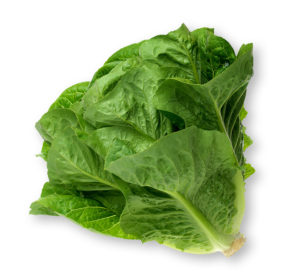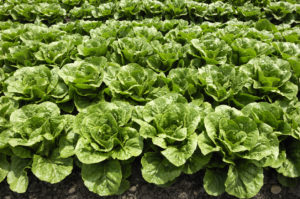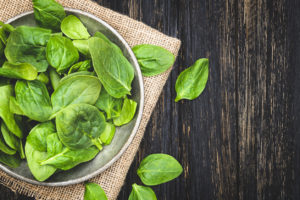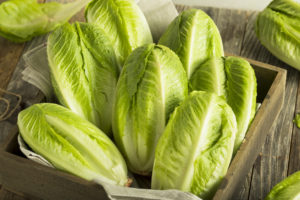Romaine Lettuce Nutrition Nutrients and Calories in Romaine Lettuce

Learn about romaine lettuce nutrition, including the nutrients and calories in romaine lettuce.
Romaine lettuce is a variety of lettuce with a thick rib at the narrow base of the leaves. Leaves become wider, flatter, and greener from the base to the tip of the leaves. Romaine lettuce hearts are usually sold individually or packaged together. They appear as a spiral of leaves larger on the outside and shrinking toward the center.
Romaine lettuce is an easy way to add nutrients to your diet without adding fat, cholesterol, or many calories.
Nutrients in Romaine Lettuce
 Many people think that because romaine lettuce is so low in calories, it must also be low in nutrients. That couldn’t be further from the truth. In fact, romaine lettuce provides several important nutrients:
Many people think that because romaine lettuce is so low in calories, it must also be low in nutrients. That couldn’t be further from the truth. In fact, romaine lettuce provides several important nutrients:
- Vitamin K
- Vitamin A
- Folate
Romaine lettuce is considered a good or excellent source of all these nutrients.
Vitamin K
Romaine lettuce is an excellent source of vitamin K, providing about 40% of your recommended Daily Value of this nutrient per cup.
Vitamin K is an important, but underappreciated nutrient. It’s vitamin D’s silent partner in utilizing calcium to build bones. Even in relatively small doses, vitamin K1, the type found in romaine lettuce, can work with vitamin D to help people with osteoporosis to add bone mass and reduce their risk of fractures.
Vitamin K also helps the body produce proteins necessary for proper blood clotting. This helps you avoid serious bleeding if you are cut.
Vitamin A
Vitamin A is a powerful antioxidant that can support heart health and reduce your risk of some types of cancer. A cup of romaine lettuce provides about 20% of the vitamin A your body needs daily.
Vitamin A is especially important for eye health. It can help reduce your risk of night blindness, cataracts, and age-related macular degeneration (AMD). AMD is when the sensitive region at the back of your eye, responsible for detailed vision and colored vision, begins to break down. It’s the leading cause of blindness in the US. In addition to vitamin A, romaine lettuce contains lutein, which is closely related. Lutein also helps combat AMD, as well as supporting brain health throughout life.
Vitamin A is also essential for healthy skin and hair. It helps your body produce the oils in your pores and hair follicles, leading to more youthful and lustrous skin, as well as strong and glowing hair.
Romaine lettuce supplies vitamin A as beta carotene. This isn’t actually active vitamin A. If you take in too much vitamin A from supplements, you might experience negative effects, but with beta carotene, your body can make the vitamin A it needs without ever getting too much.
Folate
Romaine is a good source of folate. A one-cup portion of romaine lettuce supplies 16% of your recommended daily value of folate. Folate is an essential nutrient for healthy pregnancy. Folate is a B vitamin that lowers the risk of birth defects in a baby’s brain and spine. It also helps the body produce red blood cells to reduce the risk of anemia.
Is Spinach or Romaine Lettuce Better for You?
 Both spinach and romaine lettuce are healthy leafy greens, though they provide different nutrients. The one that’s best for you is the one that you will eat regularly.
Both spinach and romaine lettuce are healthy leafy greens, though they provide different nutrients. The one that’s best for you is the one that you will eat regularly.
Comparing the nutrient values for spinach and romaine lettuce tells us how each contributes to your overall health.
Spinach and romaine lettuce are both excellent sources of vitamin K, though spinach has about three times as much as romaine lettuce. People concerned primarily about bone health might favor spinach to help preserve and build bone mass.
Romaine lettuce has about 50% more vitamin A than spinach. People who want to support eye health and healthy skin and hair might favor romaine lettuce.
Romaine lettuce and spinach contain about the same amount of folate. Therefore, both are great choices for anyone looking to support a healthy pregnancy. Spinach has an extra benefit for anyone looking to combat anemia, however, as it contains about twice as much iron as romaine lettuce.
Spinach is also better for people looking to add more vitamin C to their diet, as it contains more than four times as much of this nutrient as romaine lettuce does.
Romaine lettuce contains more fiber than spinach, which can help support digestive health.
You can see that both leafy greens provide great nutritional benefits. What’s most important is that you eat some leafy greens every day. For many people, that’s easier with romaine lettuce, which has a more neutral flavor, especially if you remove the bitter ribs. If you like both leafy greens, either mix them or trade them off to make sure you’re getting maximum nutritional benefit.
Calories in Romaine Lettuce
 Romaine lettuce is a very low-calorie food. A cup of romaine lettuce contains just 8 calories. This makes it a low-calorie food even in comparison with other vegetables.
Romaine lettuce is a very low-calorie food. A cup of romaine lettuce contains just 8 calories. This makes it a low-calorie food even in comparison with other vegetables.
Here’s how many calories are in a 1 cup serving of chopped or grated common vegetables:
- Celery: 14 calories per cup
- Cucumber: 16 calories per cup
- Bell pepper: 30 calories per cup
- Tomatoes: 32 calories per cup
- Carrot: 45 calories per cup
As you can see, romaine lettuce is a lower calorie food than other vegetables, with about half the calories of cucumber or celery. This makes romaine lettuce an excellent choice for someone looking to maintain a healthy weight while eating a diet with all the nutrition you need for healthy bones, skin, and heart.
About California LGMA
The California LGMA brings farmers together to improve the safety of lettuce and other leafy greens. LGMA membership is voluntary, but when members join, they commit to achieving 100% of the organization’s strict safety standards. Thankfully, LGMA members produce approximately 90% of the leafy greens grown in the US, helping America to have a safe supply of these tasty and nutritious vegetables. LGMA works to educate the public on the dietary value and safety of leafy greens grown in the US so that we can all confidently enjoy a healthy diet.
